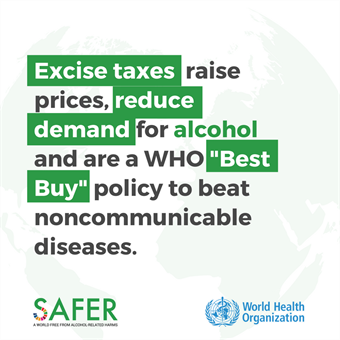Why do it?
Of all alcohol policy measures, the evidence is strongest that alcohol prices have an impact on alcohol consumption and alcohol-related harm. However, many countries underutilize alcohol taxes despite their great potential as tools to improve public health, earn revenue and redress the external costs of alcohol use – including the costs to society, the economy and health systems – as well as the cost of harm caused by alcohol to persons other than alcohol users.
When factors such as income and the price of other goods are held constant, a rise in alcohol prices leads to a reduction in alcohol consumption, and vice versa. Price increases reduce the harms caused by alcohol. Policies that increase alcohol prices delay the initiation of alcohol use, slow young people’s progression towards consuming larger amounts, and reduce heavy episodic use of alcohol among them. At the same time, these taxes can continue to generate a positive revenue for governments. Pricing and taxation have been assessed as a highly cost-effective best-buy interventions for NCD prevention.
How to do it?
To protect public health and reduce the burden of alcohol-related harm, governments should raise taxes to make alcohol less affordable. A key factor for the success of price-related policies in reducing harmful use of alcohol is an effective and efficient system of taxation matched by adequate tax collection and enforcement.
National data can be used to estimate by how much taxes should be raised on the various beverage categories in order to achieve the desired change. These projections can be supplemented by standard economic modelling studies to estimate the potential impact of the change on the health and economic burden of alcohol and on crime and productivity. Alcohol taxes should be reviewed regularly and should be increased in line with inflation.
Increased taxes do not necessarily mean increased prices when alcohol producers and retailers – particularly large supermarket chains – offset tax increases by reducing prices. One way to control this outcome is to introduce a legal minimum price per gram of alcohol. This approach establishes a floor for the price of alcohol, thus preventing the sale of very inexpensive products. This strategy can be particularly effective in reducing the total alcohol intake of heavy consumers of cheap alcohol.
Influencing the prices of the cheapest and most consumed alcoholic drinks on the market by raising the lowest prices has a potentially larger impact on total consumption than increasing the prices of more expensive alcoholic drinks that have a limited market. However, this approach means that the revenue is gained by the industry rather than by the government.
Increased taxation may meet resistance from consumer groups and economic operators. Consequently, taxation policy will benefit from the support of information and awareness-building measures to counter such resistance and to clarify the real impact of alcohol on people and communities, on jobs and economies, and on society at large.
The existence of a substantial illicit or informal market for alcohol can also complicate policy considerations for alcohol taxes. In such circumstances, tax increases should be accompanied by government efforts to control illicit or informal markets through, for instance, tax policies that make low-alcohol and nonalcoholic variations of culturally preferred beverages more attractive. Tax stamps can also be introduced to show that duty has been paid on informal products.
Cross-border trade may complicate policy for alcohol taxes. However, it is important to note that lowering taxes does not necessarily resolve cross-border issues.
Direct and indirect price promotions, discount sales, sales below cost, and flat rates for unlimited alcohol consumption or other types of volume sales have the effect of reducing the price of alcohol. This in turn increases consumption and thus increases harm – particularly the consumption and harm that results from an occasion of heavy episodic drinking. These promotions should be restricted or banned.
Whom to work with?
The main partner of the health ministry in addressing alcohol prices is the ministry responsible for setting taxes. The two ministries can act jointly to obtain the best estimates for alcohol price elasticities, as well as to model the likely impact of tax changes on the consumption of alcohol in different population groups and on mortality, hospitalization, crime and productivity.
Other important partners include the ministries and government departments responsible for collecting taxes and monitoring smuggled and illicitly or informally produced
alcohol. These partners can monitor any adverse consequences of tax changes and can institute taxes on alcohol that is currently untaxed.
Typically, alcohol producers and retailers are consulted when alcohol tax changes are contemplated. The industry tends to claim that tax increases do not reduce alcohol-related harm. The alcohol-related industry also tends to inflate the impact of taxes on its businesses and stresses the risk of unemployment. On the other hand, some parts of the industry may support minimum price measures; for instance, serving establishments may support minimum prices in order to reduce competition from off-trade establishments that practise price-cutting.




